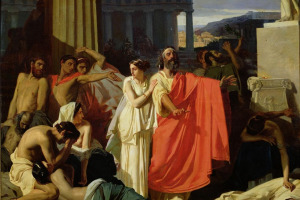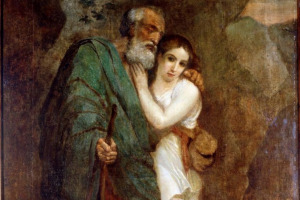Literary Devices in Antigone: Understanding Text
 Literary devices in Antigone vary far and wide and are used to create a deeper understanding of the story’s characters and their journey in the play. In Sophocles’ Greek classic Antigone, various devices are used to exhibit the creativity that our writer intends to portray, giving the audience food for thought and glimpses on what’s to come.
Literary devices in Antigone vary far and wide and are used to create a deeper understanding of the story’s characters and their journey in the play. In Sophocles’ Greek classic Antigone, various devices are used to exhibit the creativity that our writer intends to portray, giving the audience food for thought and glimpses on what’s to come.
Examples of Literary Devices in Antigone
The Greek writer did not fall short on his methods to create his masterpiece, from timeless themes to symbolism and allusions. Some of Antigone’s literary devices that were utilized are the following.
Plot
A plot is a sequence of events in a story that portrays the intended narrative and exhibits the development of the storyline. In Antigone, this begins with the death of our heroine’s two brothers, the ones who fought for control over Thebes, waging war on one another and dying in the process. Because they were both left as corpses, the following line for the throne was their uncle, Creon. The newly heralded King of Thebes passed on his first ruling; bury Eteocles and proclaim Polynices a traitor, banning the burial of his body.
The refusal to bury her dead brother did not sit well for our heroine, Antigone, who loved both of her brothers dearly and equally. She could not sit still knowing her beloved brother was being stripped of his right to be buried, preventing his soul from entering the underworld, as per Greek beliefs. Her headstrong nature hampers her from blindly following the King’s law, and so she decides to go against him in the name of Divine laws. The events that happen after unfolds our heroine’s fate, bringing her to her tragedy and the end of the Greek classic.
Theme
A theme is the main idea or the central message conveyed in a written piece. In Antigone, the major themes of the play can be subdivided into two.
Mortal Laws vs. Divine laws
This theme, in nature, can be translated to the modern equivalent of Church vs. State. In Sophocles’ Greek classic, we see Creon pass a law that directly goes against those gods. He decrees a ban on the burial of a man he heralds as a traitor, going against the gods’ wishes. The gods had proclaimed that all living creatures in death and only in death must be buried, so the people of Thebes strongly believed in the power of burials. Antigone, a citizen of Thebes, holds a strong belief in her spirituality with the gods, struggling with the current King’s ruling. She goes against mortal laws to uphold that of the gods and receive the punishment with her head held high.
Devotion vs. Duty
This theme in Antigone can be seen from the very beginning of the play. Antigone struggles with Creon’s rule as she talks to Ismene, Antigone’s sister, about the unjust refusal to bury their dead brother. Her devotion to her family and the laws of the gods surpasses that of her civic duties to mortal laws, sealing her fate in the play.
Motifs
 Motifs are recurring ideas in a play that repeat themselves to develop a particular narrative and set the story’s mood. In a written work, imagery is used to create a description that allows one to determine the genre and setting of the story. Throughout the play, imagery in Antigone can be seen from death to dirt; the play had no shortcomings when it came to recurring images, so let’s explore some of the classic’s motifs.
Motifs are recurring ideas in a play that repeat themselves to develop a particular narrative and set the story’s mood. In a written work, imagery is used to create a description that allows one to determine the genre and setting of the story. Throughout the play, imagery in Antigone can be seen from death to dirt; the play had no shortcomings when it came to recurring images, so let’s explore some of the classic’s motifs.
Death
From the very beginning of Sophocles’ play Antigone, the story had been riddled with death. From the play’s prequel Oedipus Rex, death had been a reoccurring nightmare to our characters. This carried on to Antigone, where the play began with the death of the heroine’s two brothers and ended in her death.
Blindness
Tiresias was not the only blind character in the play; our antagonist, Creon, was one. Tiresias is a blind prophet who warns Creon of his extreme hubris and how it could displeasure the gods. Creon paid him no mind and continued his reign of tyranny despite the threat of the gods. Creon, in his hubris, was blinded by pride and therefore sought his downfall as he refused the warning of others.
Allusions
Allusions shape Sophocles’ classic in a way that allows our writer to create a dynamic that captivates the audience, allowing free expression and relation to the story being portrayed. Sophocles’ utilizes this literary device in Antigone to reference his previous work and other classics to invoke deeper emotions and connections to the audience.
An example of this is the death of Antigone and her lover; the tragedy of dying for love can allude to the Shakespeare classic Romeo and Juliet. Famous at the time, this allusion allows the audience to perceive the deaths of our heroine and her lover, akin to the end of Romeo and Juliet. This elicits the same sorrow they’d felt with Romeo and Juliet’s deaths with Antigone and Haemon’s.
Symbolism
Symbolism is an artistic imitation that uses the method of revealing truths or states. In Antigone, the use of symbols can be seen as a guide to lead the audience to a better understanding of our characters and flexibility in interpretations. A prime example of this is the tombstone. At first glance, this has little to no significance to the plot’s plot, but take a closer look and focus on Antigone’s punishment for burying her brother.
As Antigone buries her brother, she is caught by palace guards and is brought to Creon for Punishment. She is entombed in a cave meant for the dead for her transgressions and dies in the shelter as well. Antigone has shown Creon’s defiance and makes it apparent that she holds no loyalty to him. She is wholly devoted to her brother and the will of the gods, subtly hinting at her allegiance to the dead instead of to the current King of Thebes. With this, she is buried alive and put with the dead. Creon sees this as an appropriate punishment for the sinner who has turned her back on the living and ran towards the deceased.
For the gods, a tombstone is a sinful act against Zeus. Creon refused to honor the gods’ will to bury the dead in refusing to bury Polyneices’ body and then went to dishonor them yet again when he buried Antigone, the living. Because of this, tragedy strikes Creon in the form of the deaths of both his son and wife. This figurative speech in Antigone allows Sophocles to go beyond the literal meaning of words to get a message or point across.
Metaphors
In Antigone, metaphors in Antigone are used for rhetorical effect and provide clarity or identification in hidden similarities between two different ideas. For example, while being caught burying her brother, the palace guards compared Antigone to a hyena stating, “There she is, clawing away like a hyena.” This connotes that Antigone was akin to a wild animal, crazy in her wild tryst against Creon and uncivilized in how she acted, thus distracting the audience and the guards from her actual position—royalty.
This figurative language in Antigone allows the audience to grasp the situation better by bringing up details in comparison. For example, if the guards were to say, “There she is clawing away,” the meaning behind their words would be lost entirely as opposed to “There she is, clawing away like a hyena.” Antigone’s comparison to a Hyena illuminates the audience in how she acts and how other characters perceive her.
Conclusion:
We’ve talked about the different literary devices found in Sophocles’ Greek classic. Now, let us go over the main points we discussed:
 Sophocles utilizes literary devices to exhibit creativity and allow the audience to form deeper connections with the characters of his play.
Sophocles utilizes literary devices to exhibit creativity and allow the audience to form deeper connections with the characters of his play.- The plot is used to create a narrative and exhibit the events of the story.
- The theme is used to portray the main ideas of the play and can be divided into two: mortal law vs. divine law; and duty vs. devotion.
- Motifs are recurring themes that use imagery to portray the story’s intent and mood.
- Allusions are used to shape the classic to allow the writer to create a dynamic that captivates the audience, allowing free expression.
- Allusions are also used to invoke deeper emotions and relations to the audience.
- Symbolisms offer freedom in different interpretations of the work
- Metaphors provide clarification in hidden similarities between two ideas, allowing comparison and understanding
In conclusion, Sophocles uses literary devices to freely express his intent and maximize the creativity put into his written work. With various literary devices placed in a particular position, the author gives the audience a deeper understanding of the play and invokes more incredible emotion.
An example of this is the allusion of Antigone and Haemon’s death. The lovers’ deaths elude the tragic ending of Shakespeare’s classic, and so the emotions evoked from Romeo and Juliet’s tragic end carry themselves to the deaths of Antigone and Haemon.

